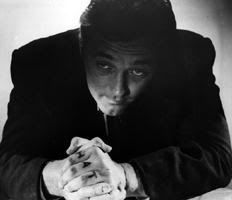It's a hard world for little things.

The following is an essay about one of my all-time favorite films that I wrote for my Writing Composition class. It's intended for a "general audience," so it spells out a few things that those of you who regularly read this blog might already know about. But I thought you might enjoy it nonetheless.
"Two terrified children, a boy and a girl, huddle together, amongst the piles of coal in their fruit cellar. At the top of the stairs, a dark, shadowy figure appears, darkening the doorway like the Grim Reaper dressed in a preacher’s clothes. “Chilll-dren!” he croons in a fearsome baritone drawl. “Chilll-dren? I can hear you whisperin’, children, so I know you’re down there. I can feel myself getting’ awful mad. I’m running out of patience, children. I’m coming to find you.”
This image is one of many that was etched into the memories of those who saw legendary character actor Charles Laughton’s lone directorial effort, The Night of the Hunter. Although it was panned by critics and ignored by audiences upon its initial release in 1955, this story of a psychotic preacher, who marries and murders a bank robber’s widow and peruses her two orphans across the Depression-era South in search of a stolen fortune, has planted seeds in the soil of our cultural landscape, never to be forgotten by those who were bewitched by its beauty.
But what exactly is so special about this film? There was never another like it, before or since. Laughton, whether consciously or unconsciously, broke several unwritten but ironclad rules of filmmaking when he brought this story to the screen. Remember that in the mid-fifties, it would be several decades until cinema would come to be recognized as an art form. At that time, filmmaking was strictly a craft and a business. Even though most films were shot on soundstages, all the characters had an off-screen “reality” as actors, and there were producers and a director controlling the whole thing, it was uncharacteristic of a movie to remind the audience of this fact. Movies never let on that there was someone behind the camera, that everything the audience saw was a fabrication- to do so would be considered bad filmmaking. The Night of the Hunter broke this rule by staging several key scenes, such as the aformentioned one in the cellar, and when Preacher Harry Powell murders the children’s mother, Willa, on dollhouse-like interior sets where the walls cut away into black nothingness. Other directors at the time would have framed such shots closer inside the room, not letting on that the set was actually just a set. But in shooting those scenes the way he did, Laughton emphasized their symbolism – the fruit cellar was a terrifying hell from which the children needed to escape, and the master bedroom, with its pointed ceiling resembling a church steeple, is where Harry Powell consummates his marriage to Willa Harper by cutting her throat rather than going to bed with her.
That’s the other thing that sets The Night of the Hunter apart – its symbolism, which is unabashedly overt. Robert Mitchum’s preacher is the proverbial wolf in sheep’s clothing, with the words “love” and “hate” tattooed on his knuckles. “Would you like me to tell you the little story of right-hand-left-hand?” he jovially asks the gullible townsfolk. “The story of Good and Evil?” It is indeed this struggle, which Powell illustrates by creepily arm-wrestling himself. The children, John and Pearl, represent good, and their love and trust is taken advantage of by evil Powell, when he takes on the role of their wicked stepfather. With their mother dead, and John’s only friend (a kindly old alcoholic who calls himself Uncle Bertie) drunk into a stupor when he needs him the most, the children flee down the river under the cover of darkness. Their rowboat glides smoothly down the river, past various types of predators and prey in the foreground (rabbits, toads, foxes, and owls), until they reach the home of the matriarchal Mrs. Cooper, played by Lillian Gish. Mrs. Cooper takes the children in, relieving them of their premature burden, and serving as their protector against Harry Powell. In the film’s haunting climatic scene, Cooper sits in her rocking chair on the porch in a trance-like state, clutching a shotgun, and challenging the false piety of Powell’s eerie hymn “Leaning on the Everlasting Arms” with the correct lyrics, “Leaning on Jesus.” Eventually, Powell vanishes into the night and we see a barn owl perched on a limb descend upon a helpless rabbit. Upon hearing the squeals of the poor animal, Mrs. Cooper sighs and proclaims, “It’s a hard world for little things.”
Such overt symbolism undoubtedly turned audiences and critics off in 1955, who must have found the Biblical and fairy tale references hokey. Of course, the same people probably cared little for Citizen Kane, It’s A Wonderful Life, and Vertigo, all of which suffered a similar fate upon their release. To the true believers in the cinema, The Night of the Hunter is a beautiful tapestry of nightmare imagery, Bible stories, and the Brothers Grimm, and fully deserving of its place among the greatest motion pictures of all time."


1 Comments:
This article is interesting and useful. And let me share an article about health which insha Allah will be very useful if we use it again for others.
Obat Untuk Mengobati penyakit osteoarthritis
Obat Untuk Penyakit TBC
Cara Mengobati Jamur Mulut
Cara Pemesanan QnC Jelly Gamat
Cara Mengobati Telinga Berair
Bahaya Penyakit Muntaber dan cara mengatasinya
Post a Comment
Subscribe to Post Comments [Atom]
<< Home